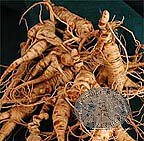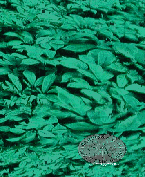Harding's
Wild Mountain Herbs
P.O. Box 53
Friendsville, MD 21531
301-746-5380









Ginseng is sometimes a difficult plant to grow. It is a plant that requires commitment for the fact that roots are best when left to maturity for 5-10 years. It is a committed gardener that decides to plant a crop, waiting 5-10 years to harvest the best and most potent roots is a task filled with risk, patience, and an eye to the distant future.
Long used as an herbal remedy, Ginseng Panax brings the mystique of the Orient to your patio, backyard, perennial garden or woodland plot. Stunning in bloom, this conversation piece is particularly attractive when massed beneath a grove of shade trees, or cascading down a forested hillside toward a rocky stream.
Ginseng did not get its reputation as a tonic and healing herb for nothing. The quest to grow wild simulated ginseng can be more than a hobby. It can be a reconnection with having faith in Nature's ability to provide cures in things that are healthy for us. Growing in the deep woods, it is not naturally a plant of the cultivated field. To grow it in its natural habitat is to remain connected to the forest, for the trees are your allies.
You can recreate the shady environment and conditions to grow ginseng in a flower pot, or locate the perfect spot in your yard or garden. If you have nice woods on your property you might consider a crop (see wild simulated).
We can ship you stratified seeds. Ginseng seeds will only sprout after two years natural storage (stratified seed).
Many folks prefer our roots which are two or three year old entire roots (the ginseng root must remain whole to grow, unlike the goldenseal root which can be cut into sections/rootlets). We send you directions on growing, all you have to do is be ready to plant when you get them.
It is best to transplant the rootlets in spring and fall. Usually March and April just before they begin to bud. In the fall after the berries have fallen off is also a good time. Handle root delicately, taking care not to disturb the root during all transplanting procedures. Plant it in the fall and leave it alone until it comes up in the spring.
Ginseng requires 80 percent shade to thrive and prefers a deep rich loamy soil. Organic humus works well. It also requires good drainage.
The Wild-Simulated Method
A Method called wild-simulated can be used to grow ginseng without fungicide sprays and expensive establishment costs. The prices paid for genuine wild-simulated roots approach that of wild roots. It takes an expert to really tell them apart.
Ginseng cultivation is risky The crop can be stolen or eaten by rodents. The chosen site may not be right. Plant diseases will certainly occur. On the other hand if the right conditions can be found, wild-simulated cultivation can provide supplemental income and expose us to a form of agriculture that is in harmony with the forest. It is a completely natural process.
The first step is site selection. Favorable soil and moisture conditions are most often associated with north or east facing slopes with at least 75 percent shade canopy. This is dense shade we're talking about. The best shade is provided by deep rooted, deciduous trees such as Poplar and Oaks. Ginseng grows best in a moist well drained soil. That is a contradiction, but these soils do exist. Successful growth of ginseng most often occurs in sites where herbaceous woodland plants such as Jack-in-the-Pulpit, Bloodroot, Solomon's Seal and ferns are thriving. If no herbaceous plants are growing on the forest floor, ginseng will probably not grow there. Excellent soil drainage is essential and swampy or clay soil must be avoided.
In the wild-simulated method, stratified ginseng seed is planted in the
fall when the trees lose their leaves. In some locations, clearing of
undergrowth will be necessary. If the site is sufficiently shaded, there
should not be a great deal of competitive weed growth. Avoid dense patches
of weeds, and disturb the site as little as possible to reduce the spread
of fungal disease.
It is recommended that only stratified seed be planted. Freshly harvested
seed that is placed in the sand is known as 'green seed'. Planting stratified
seed means that the seed is only vulnerable for a very short time period
(as opposed to 18 months in natural conditions) and survival rates are
much greater.
The only tools needed to plant wild simulated ginseng are a rake and a garden hoe. It is a good idea to plants seeds in generally defined beds that are five feet wide and up to fifty feet long. The beds can be separated by three foot walkways. The beds should run up and down the slope rather than across the slope for better air and water drainage around the plants. Rake the leaves on the forest floor away from the bed right down to the topsoil. Using the hoe, make three narrow furrows 18 inches apart, all the way down the length of the bed. Plant seeds by hand, three inches apart in each furrow. About one ounce or 500 seeds will be needed to plant three furrows at this spacing in a bed that is five feet wide and fifty feet long.
Cover the seeds with 1 1/2 inches of topsoil. After planting, carefully step down each row to firm the soil around the seeds. To finish planting, rake one inch of leaves back over the bed as mulch. After a couple of rainstorms no one will be able to detect that any planting has occurred. The site should look completely natural.
The stratified seed will germinate next spring. The plants will look
like three small strawberry leaves on a stem about an inch tall. Some
of the seeds will not germinate, and some will be eaten by rodents. Over
the next seven years, the plant population in each bed will be reduced
every year by various natural forces. The final stand will most likely
be a thin healthy population of wild ginseng plants.
In the wild-simulated method, after planting, little or no work is required
until harvest 7-10 years later. The ginseng plants are left to the mercy
of nature. Weeds will compete with the plants for water and nutrients,
the plants will struggle to grow in barely cultivated soil. These stressful
conditions result in the wild appearance of the roots that are eventually
harvested. Digging the roots is difficult because the roots are entangled
with other woodland plants. Harvested roots should be air dried in the
shade.
A half acre will require 10 pounds of seeds and will yield anywhere from 0 to 200 pounds of dried root in 6 to 10 years.
The greatest threat is theft and crops should not be grown in areas where people dig wild ginseng. It is best to plant on controlled land and to keep quiet about the enterprise. Growing ginseng away from the mountains where most ginseng hunters search is also a good way to keep the crop safe. Someone may come across it but probably would not know what it was.
Ideal growing conditions for ginseng are more difficult to find in low-lying regions than they are in the mountains. The forest floor in most woodland areas is too hot and dry during the summer for ginseng to thrive. (Moist environments may be found that are good, if not perfect, places to grow ginseng.) Small pockets of cooler soil may be found very often on a north facing hillside above a stream or river. Many landowners with the right conditions are successfully growing ginseng well out of the mountains.
Stratified Ginseng Seed
We harvest the plants and collect the seed, and then we put the seeds
in moist sand for one year. This process helps protect the seed from predators
and mother nature while the embryo develops and grows. After one year
we remove the seed from these special seed boxes and it is ready to be
planted. Stratified seed should be planted throughout the fall and into
early spring (September through March). Seeds sprout in spring.
All Text, Images and Graphics are ©Harding's
Wild Mountain Herbs 2008-2011
All Rights Reserved ~ No Usage or Reproduction is Allowed Without
Expressed Written Consent


